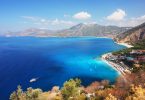Whether we take a look at Ekrem Akurgal’s book titled ‘The Anatolian Civilisation’, published in 1987 or Remzi Oğuz Arik’s ‘Turkish Museology’ published in 1946 and which could be used as a reference source; the indisputable conclusion that we shall reach is the fact that Anatolia, and hence Turkey, is one of the largest and most important historical and cultural centres of the world.
This historical and cultural portrait of Anatolia and Turkey is such a great fact that, we also come across this truth in many other important research just like those we have mentioned earlier.
In relation to Turkey’s cultural and historical accumulation of 12,500 years, another research that could be considered a classic is the work edited by Gül Pulhan titled ‘World Heritage in Turkey’, which was published in 1996 by the Ministry of Culture and Tourism of the Republic of Turkey. The book also draws much attention in terms of integrity of texts and photographic collections.
Following this work of the Ministry of Culture and Tourism of the Republic of Turkey, which drew much attention and includes the Turkish works as well as the periodic world heritage, there have been other monuments that have been added to the list of the World Heritage since the year 2011. Edirne Selimiye Mosque and its Social Complex, the Çatalhöyük Neolithic Town, the multiple-storey landscape of Bergama and Bursa Cumalıkazık are amongst the top on this list. By considering these works it could be stated that Turkey´s natural and cultural heritage carries an importance of compelling and changing the literature of the museology of the world.
In this sense, if we were to arrange these astonishing cultural and natural heritage samples mentioned in temporary listings that have been confirmed as world heritage discoveries within the past 20 years, it shall become necessary to emphasise Turkey´s new cultural and natural actuality that shall surface before us.
For instance, if we were to begin with Alanya, we could then extend to the Alahan Monastery in Mersin, from Efes to the Karain Caves, the Ancient Settlement of Ahlat in Bitlis, the Dıyarbakir Castle and its city walls, Harran and the Settlements in Şanlıurfa, and from the Ishakpaşa Palace in Ağrı to the Seljuk Heritage in Konya and similarily, speak and draw attention to the numerous natural and cultural wealth of the Mardin Cultural Landscape and the ancient city ruins of Perge that draws much attention in Denizli and Doğubayazıt.
While our addressees stand in wonder before such historical and natural wealth that clearly awakens a deep astonishment, we could easily add the archeological excavations taking place in Göbeklitepe, Şanlıurfa and speak of the Adana Anavarza Ancient Settlement that has recently been declared and also of the many other important natural and cultural heritage that could prolong this list with the mere mention of its names and special articles.
A BOOK, AN EXHIBITION AND ACTIVITIES
It is for this reason that we realise that these lands that we live on necessitate a larger discourse and in this sense, although it may seem like an absolute assertion, we need to claim that Turkey is truly the largest museum of the world and in this context there are many works that ought to be published, along with exhibitions and other kinds of activities.
For instance, the project ¨The World´s Largest Museum: Turkey¨, which was held at the end of 2014 for the purpose of carrying the cultural, natural and historical values of Turkey to a universal platform, was a crucial step taken in asserting and drawing attention to introducing our country´s natural, cultural and historical wealth in the national and international arena.
The Project ¨The World´s Largest Museum: Turkey¨, which was organised under the Ministry of Culture and Tourism of the Republic of Turkey, as well as the book exploring the history of the Anatolian civilisation with photographs and the exhibitions organised both nationally and overseas with photographs taken for this project and lastly the documentary series of 13 films can all be considered a critical move.
This work which had been organised between November 14, 2014 and December 31, 2014 with the intention of exposing a visual festival of the story of our 12,500 year old Anatolian history, shall fill in a deep gap with all of the hundreds of photos taken at all of the museums and archeological sites and the interesting stories behind these photographs compiled in a book. Furthermore, with the exhibitions as part of the Project and the documentaries shown on television most surely provided its share in developing the national and international tourism.









Leave a Comment